
Emeric Pressburger was a Hungarian-British screenwriter, film director, and producer. He is best known for his series of film collaborations with Michael Powell, in a collaboration partnership known as the Archers, and produced a series of films, including 49th Parallel (1941), The Life and Death of Colonel Blimp (1943), A Matter of Life and Death, Black Narcissus (1947), The Red Shoes (1948), and The Tales of Hoffmann (1951).

The British film-making partnership of Michael Powell (1905–1990) and Emeric Pressburger (1902–1988)—together often known as The Archers, the name of their production company—made a series of influential films in the 1940s and 1950s. Their collaborations—24 films between 1939 and 1972—were mainly derived from original stories by Pressburger with the script written by both Pressburger and Powell. Powell did most of the directing while Pressburger did most of the work of the producer and also assisted with the editing, especially the way the music was used. Unusually, the pair shared a writer-director-producer credit for most of their films. The best-known of these are The Life and Death of Colonel Blimp (1943), A Canterbury Tale (1944), I Know Where I'm Going! (1945), A Matter of Life and Death (1946), Black Narcissus (1947), The Red Shoes (1948), and The Tales of Hoffmann (1951).

One of Our Aircraft Is Missing is a 1942 British black-and-white war film, mainly set in the German-occupied Netherlands. It was the fourth collaboration between the British writer-director-producer team of Michael Powell and Emeric Pressburger and the first film they made under the banner of The Archers.
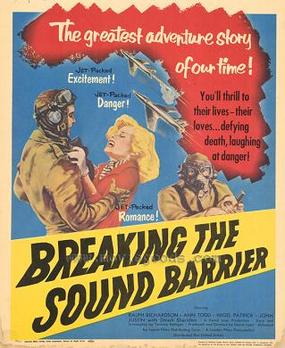
The Sound Barrier is a 1952 British aviation drama film directed by David Lean. It is a fictional story about attempts by aircraft designers and test pilots to break the sound barrier. It was David Lean's third and final film with his wife Ann Todd, but it was his first for Alexander Korda's London Films, following the break-up of Cineguild. The Sound Barrier stars Ralph Richardson, Ann Todd, John Justin and Nigel Patrick. It was known in the United States as Breaking Through the Sound Barrier and Breaking the Sound Barrier.

Eric Harold Portman was an English stage and film actor. He is probably best remembered for his roles in three films for Michael Powell and Emeric Pressburger during the 1940s.

It’s in the Air is a 1938 British comedy film written and directed by Anthony Kimmins and starring George Formby, Polly Ward and Jack Hobbs. The film was released in the United States with the alternative title George Takes the Air in 1940. The film depicts Great Britain's preparations for war with Air Raid Warden training, mock air attacks dropping poison gas bombs, and the deployment of anti-aircraft weapons in the streets.

The Supermarine Southampton was a flying boat of the interwar period designed and produced by the British aircraft manufacturer Supermarine. It was one of the most successful flying boats of the era.

Angels One Five is a 1952 British war film directed by George More O'Ferrall and starring Jack Hawkins, Michael Denison, Dulcie Gray, John Gregson, Cyril Raymond and Veronica Hurst. Based on the book What Are Your Angels Now? by Pelham Groom, the plot centres on a young fighter pilot immediately before and during the Battle of Britain in the Second World War. Some scenes in the film were shot at RAF Uxbridge, where there was a wartime operations room.

Death in the Air is a 1937 American film directed by Elmer Clifton and starring Lona Andre, John Carroll, Leon Ames and Henry Hall. The film is also known as Murder in the Air in the United Kingdom and as The Mysterious Bombardier. The film was Fanchon Royer's first production for her new company, Fanchon Royer Features, Inc. Film Daily reported that former FBI agent Melvin Purvis was offered a role in the film but declined.
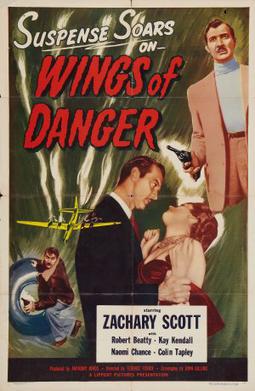
Wings of Danger is a 1952 British second feature crime film directed by Terence Fisher and starring Zachary Scott, Robert Beatty and Kay Kendall. The screenplay, based on the 1951 novel Dead on Course by Trevor Dudley Smith and Packham Webb, concerns a pilot who is suspected of smuggling. It was released in the United States under its working title of Dead on Course.

The Net is a 1953 British aviation thriller film made by Two Cities Films, directed by Anthony Asquith and starring James Donald, Phyllis Calvert, Robert Beatty and Herbert Lom. The film is set in the world of aviation research and was based on the 1952 novel of the same name by John Pudney.
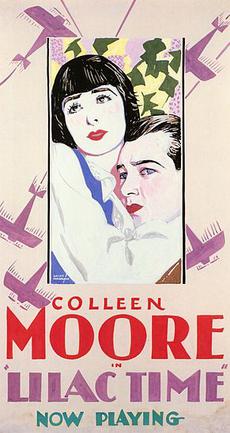
Lilac Time is a 1928 American synchronized sound romantic war film directed by George Fitzmaurice and starring Colleen Moore and Gary Cooper. While the film has no audible dialog, it was released with a synchronized musical score with sound effects using the sound-on-disc Vitaphone process. The film is about young American aviators fighting for Britain during World War I who are billeted in a field next to a farmhouse in France. The daughter who lives on the farm meets one of the new aviators who is attracted to her. As the flyers head off on a mission, the young aviator promises to return to her.
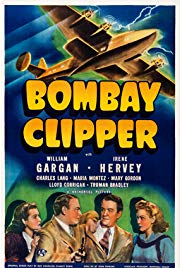
Bombay Clipper is a 1942 aviation drama film directed by John Rawlins and starring William Gargan and Irene Hervey. The film features Maria Montez in an early role. Turhan Bey also appears.

Sky Devils, also known as Ground Hogs, is a 1932 American Pre-Code aviation comedy film, starring Spencer Tracy as a draft dodger who blunders into a war zone.

Flying Fortress is a 1942 British black-and-white war film drama from Warner Bros. Pictures, produced by A. H. Soloman, directed by Walter Forde, that stars Richard Greene and co-stars Carla Lehmann, Betty Stockfeld, and Donald Stewart.
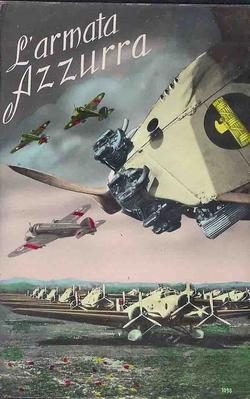
L'Armata Azzurra is a 1932 Italian aviation docu-drama and adventure film directed by Gennaro Righelli and starring Germana Paolieri and Ennio Cerlesi. It was Italy's first aviation drama film, with a fictional story that celebrated the Italian Air Force.

The Great Air Robbery is a six-reel silent 1919 American drama film directed by Jacques Jaccard and produced by Universal Pictures. The film stars Ormer Locklear, Allan Forrest and Ray Ripley. The Great Air Robbery is a film that showcases the talents of stunt pilot Locklear, considered the foremost "aviation stunt man in the world", and depicts pilots flying air mail, the first film to deal with the subject. There are no known archival holdings of the film, so it is presumably a lost film.

Captain Swagger is a 1928 American synchronized sound crime drama film directed by Edward H. Griffith and stars Rod La Rocque. While the film has no audible dialog, it was released with a synchronized musical score with sound effects utilizing the RCA Photophone sound-on-film sound system. The film was released with both the sound-on-disc and sound-on-film formats. The film was produced and distributed by the Pathé Exchange company.
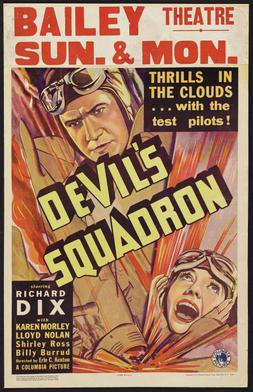
Devil's Squadron is a 1936 American drama film directed by Erle C. Kenton and starring Richard Dix, Karen Morley and Lloyd Nolan. The following written prologue appears after the opening credits: "This picture is dedicated to the test pilots....those men who knowingly face death every time they leave the ground in an untried airplane. We never hear of these men, yet on their courage depends the future of aviation."
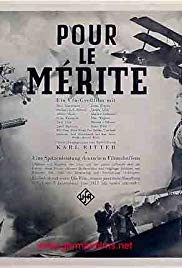
Pour le Mérite is a 1938 propaganda film produced and directed by Karl Ritter for Nazi Germany. The film follows the story of officers of the Luftstreitkräfte in the First World War who were later involved in the formation of the Luftwaffe. Pour le Mérite propagates the "stab legend", which consigns the German military defeat in World War I to an alleged treason in the homeland. At the same time, Ritter also glorifies the former fighter pilots as heroes of National Socialism.




















